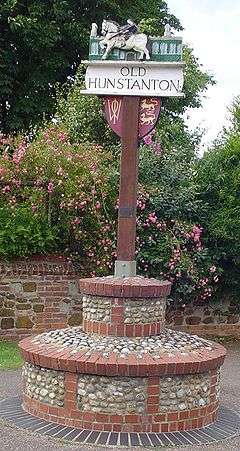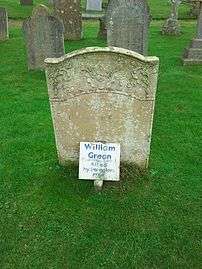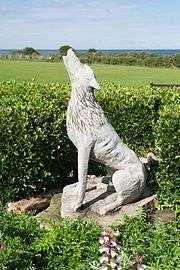Old Hunstanton
| Old Hunstanton | |
|---|---|
 Signpost in Old Hunstanton | |
 Old Hunstanton Old Hunstanton shown within Norfolk | |
| Area | 5.35 km2 (2.07 sq mi) |
| Population | 628 (2011) |
| • Density | 117/km2 (300/sq mi) |
| OS grid reference | TF683422 |
| Shire county | |
| Region | |
| Country | England |
| Sovereign state | United Kingdom |
| Post town | HUNSTANTON |
| Postcode district | PE36 |
| Police | Norfolk |
| Fire | Norfolk |
| Ambulance | East of England |
| EU Parliament | East of England |
Old Hunstanton is a village and civil parish in the English county of Norfolk. It covers an area of 5.35 km2 (2.07 sq mi) and had a population of 47 in 25 households at the 2001 census.[1] The population had risen to 628 at the 2011 Census.[2] For the purposes of local government, it falls within the district of North Norfolk.
This small settlement adjoins to the north of the larger resort of Hunstanton or New Hunstanton. The quiet character of Old Hunstanton remains distinct from and complements that of its busy sibling, with clifftop walks past the disused Old Hunstanton Lighthouse and the ruins of St Edmund's Chapel, built in 1272. King Edmund supposedly built the village. The River Hun runs to the coast just to the east of old Hunstanton.
The parish church of St Mary, situated in the grounds of Hunstanton Hall, is a Grade I listed building.[3] It was built by Sir Hamon le Strange in about 1300 and extensively rebuilt and restored during the 19th century by architect Frederick Preedy for Henry Le Strange (1815–1862), developer of New Hunstanton.
St Mary's churchyard contains the graves of a customs officer (William Green) and a soldier (William Webb), both of whom were fatally wounded during a skirmish on the Hunstanton coast with smugglers. The clash occurred on the night of 25 September 1784, also claiming the life of another customs officer named Rennett. However, although the alleged perpetrators were tried at Thetford the following year it proved impossible to secure any convictions.[4][5]
At Old Hunstanton is a RNLI Lifeboat station with a B class (Atlantic) boat and a Hovercraft.
Parts of the beach are backed by sand dunes and are the location for beach huts. Storms deposit items on the beach including marine life this may be strandings of cetaceans, mass strandings of starfish and shellfish or boats wrecked in storms.[6]
In December 2011 a large whale washed ashore on the beach.[7]
At low tide there is a small Lagoon named after a local kitersurfer born and bred in Hunstanton - Mews Lagoon.
 Old Hunstanton Village Sign
Old Hunstanton Village Sign William Green's grave
William Green's grave Wolf sculpture marking the spot overlooking where St. Edmund landed in 855
Wolf sculpture marking the spot overlooking where St. Edmund landed in 855
History
The village of Old Hunstanton is recorded in the Domesday Book as ‘Hunestanestada’. Later it became part of the Le Strange family estates.[8]
References
- ↑ Census population and household counts for unparished urban areas and all parishes Archived 2017-02-11 at the Wayback Machine.. Office for National Statistics & Norfolk County Council (2001). Retrieved 20 June 2009.
- ↑ "Parish population 2011". Retrieved 28 August 2015.
- ↑ Historic England. "Details from listed building database (1077920)". National Heritage List for England. Retrieved 13 February 2015.
- ↑ Records of the Norfolk Yeomanry Cavalry, to which is added the fencible and provisional Cavalry of the same county from 1780 to 1908. (Jarrold, 1908). p.30,31
- ↑ Codd, Daniel (2013). Tales from the Gibbet Post (The Murder of Customs Officers). Amazon Media EU S.à r.l. Kindle Edition. ASIN: B00D2B8OWA
- ↑ anonymous (2018). Hunstanton guide book. Hunstanton and District Civic Society.
- ↑ http://www.lynnnews.co.uk/news/latest-news/call_for_action_over_whale_body_in_hunstanton_after_jaw_bone_hacked_off_1_3375376
- ↑ anonymous (2018). Hunstanton Guide Book. Hunstanton and District Civic Society.
External links
| Wikimedia Commons has media related to Old Hunstanton. |